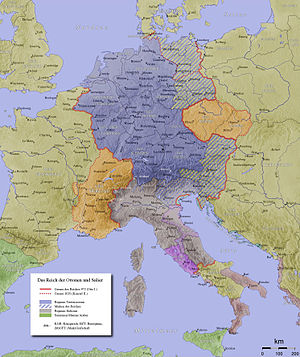Carniola
As a hereditary possession of the Habsburgs (one of the so-called Erblande), Carniola was part of the Austrian Circle of the Empire from the early 16th century.
The principal cities and towns in the region were Kamnik, Kranj, Tržič, Vrhnika, Vipava, Idrija, Turjak, Ribnica, Metlika, Novo Mesto, and Vače.
Before the coming of the Romans (c. 200 BC), the Taurisci dwelt in the north of Carniola, the Pannonians in the southeast, the Iapodes or Carni, a Celtic tribe, in the southwest.
The new inhabitants, to whom modern historiography frequently refers to as Alpine Slavs, were subjected to the Avars, but around 623 they joined the Slavic tribal union of Samo.
After the division of Friuli, it became an independent margraviate, having its own Slavic margrave residing at Kranj, subject to the governor of Bavaria at first, and after 976 to the Dukes of Carinthia.
[5] Among secular potentates, the Dukes of Meran, Gorizia, Babenberg, and Zilli held possessions given to them in fief by the patriarchs of Aquileia.
[5] Ottokar was defeated by Rudolph I of Germany, and at the meeting at Augsburg in 1282, he gave in fief to his sons Albrecht and Rudolf the province of Carniola, but it was leased to Meinhard, count of Gorizia-Tirol.
When Henry died 1335 Jan, King of Bohemia, renounced his claims, and Albrecht, Duke of Austria, received Carniola; it was proclaimed a duchy by Rudolf IV, in 1364.
After they had embraced Christianity in the seventh and eighth centuries Charlemagne conferred the major part of Carniola on the Patriarchate of Aquileia, and the remainder on the Diocese of Trieste.
It was bounded on the north by Carinthia, on the north-east by Styria, on the south-east and south by Croatia, and on the west by Trieste, Goritza, and Istria; with area of 3,857 square miles (9,990 km2) and population of 510,000.
Politically the province was divided into eleven districts consisting of 359 municipalities; the provincial capital was the residence of the imperial governor.
The districts were: Kamnik, Kranj, Radovljica, the neighbourhood of Ljubljana, Logatec, Postojna, Litija, Krsko, Novo Mesto, Crnomelj, and Gotschee or Kocevje.
[5] The duchy was constituted by rescript of 20 December 1860, and by imperial patent of 26 February 1861, modified by legislation of 21 December 1867, granting power to the home parliament to enact all laws not reserved to the imperial diet, at which it was represented by eleven delegates, of whom two elected by the landowners, three by the cities, towns, commercial and industrial boards, five by the village communes, and one by a fifth curia by secret ballot, every duly registered male twenty-four years of age has the right to vote.
The landed interests elected ten members, the cities and towns eight, the commercial and industrial boards two, the village communes sixteen.
The business of the chamber was restricted to legislating on agriculture, public and charitable institutions, administration of communes, church and school affairs, the transportation and housing of soldiers in war and during manoeuvres, and other local matters.
The western part of the duchy, with the towns of Postojna, Ilirska Bistrica, Idrija, and Šturje, was annexed to Italy in 1920, but was subsequently also included in Yugoslavia in 1947.





